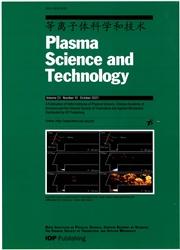Experimental study on the effect of H2O and O2 on the degradation of SF6 by pulsed dielectric barrier discharge
IF 1.6
3区 物理与天体物理
Q3 PHYSICS, FLUIDS & PLASMAS
引用次数: 0
Abstract
SF6 has excellent insulation performance and arc extinguishing ability, and is widely used in the power industry. However, its global warming potential is about 23500 times that of CO2, and it can exist stably in the atmospheric environment, is not easy to degrade, and has great potential harm to the environment. Based on pulsed dielectric barrier discharge plasma technology, the effects of H2O and O2 on the degradation of SF6 were studied. Studies have shown that H2O and O2 can effectively promote the decomposition of SF6 and improve its degradation rate and energy efficiency. Under the action of pulse input voltage and an input frequency of 15 kV and 15 kHz respectively, when H2O has added alone, the effect of 1 % H2O is the best, and the degradation rate and energy efficiency of SF6 reach the maximum, which is 91.9 % and 8.25 g/kWh, respectively. The synergistic effect of H2O and O2 on the degradation of SF6 was similar to that of H2O. When the concentration of H2O and O2 was 1 %, the system obtained the best degradation rate and energy efficiency, which were 89.7 % and 8.05 g / kWh, respectively. At the same time, different external gases exhibit different decomposition product regulation capabilities. The addition of H2O can effectively improve the selectivity of SO2. Under the synergistic effect of H2O and O2, with the increase of O2 concentration, the degradation products gradually transformed into SO2F2.脉冲介质阻挡放电中 H2O 和 O2 对 SF6 降解影响的实验研究
SF6 具有优异的绝缘性能和灭弧能力,被广泛应用于电力行业。但其全球变暖潜势约为 CO2 的 23500 倍,且能稳定存在于大气环境中,不易降解,对环境的潜在危害极大。基于脉冲介质阻挡放电等离子体技术,研究了 H2O 和 O2 对 SF6 降解的影响。研究表明,H2O 和 O2 能有效促进 SF6 的分解,提高其降解率和能效。在脉冲输入电压和输入频率分别为 15 kV 和 15 kHz 的条件下,单独添加 H2O 时,1 % H2O 的效果最好,SF6 的降解率和能效达到最大值,分别为 91.9 % 和 8.25 g/kWh。H2O 和 O2 对 SF6 降解的协同效应与 H2O 相似。当 H2O 和 O2 的浓度为 1 % 时,系统获得了最好的降解率和能效,分别为 89.7 % 和 8.05 g/kWh。同时,不同的外部气体表现出不同的分解产物调节能力。H2O 的加入能有效提高 SO2 的选择性。在 H2O 和 O2 的协同作用下,随着 O2 浓度的增加,降解产物逐渐转化为 SO2F2。
本文章由计算机程序翻译,如有差异,请以英文原文为准。
求助全文
约1分钟内获得全文
求助全文
来源期刊

Plasma Science & Technology
物理-物理:流体与等离子体
CiteScore
3.10
自引率
11.80%
发文量
3773
审稿时长
3.8 months
期刊介绍:
PST assists in advancing plasma science and technology by reporting important, novel, helpful and thought-provoking progress in this strongly multidisciplinary and interdisciplinary field, in a timely manner.
A Publication of the Institute of Plasma Physics, Chinese Academy of Sciences and the Chinese Society of Theoretical and Applied Mechanics.
 求助内容:
求助内容: 应助结果提醒方式:
应助结果提醒方式:


